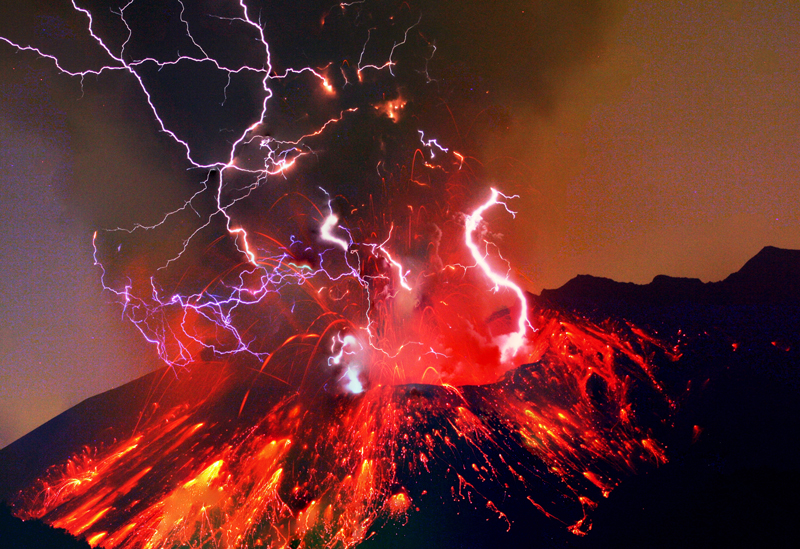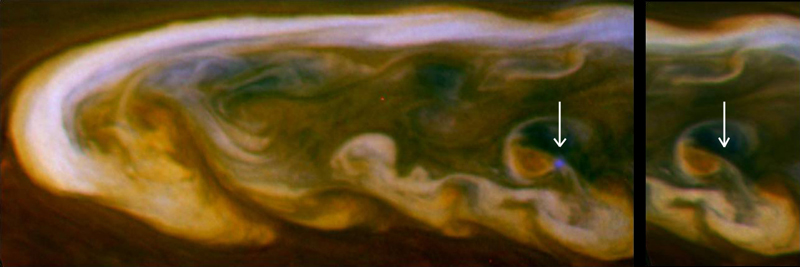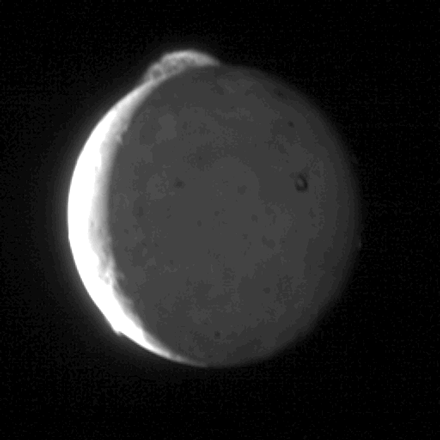A translation of this article was made possible by a partnership with Planeteando. Una traducción de este artículo fue posible gracias a una asociación con Planeteando.
What do you think of when you imagine lightning?
If you pictured a zigzagging bolt of electricity striking the ground from a rolling thundercloud, you’re right. If you pictured elves, sprites, spiders, jets, or volcanoes, you’re also correct.
You’re also right if you pictured any of those phenomena on another planet.
In 1979, NASA’s Voyager 1 spacecraft flew past Jupiter and saw flashes of light illuminating areas of the planet’s nighttime sky larger than the United States. Accompanying those flashes were extremely low frequency radio signals, called whistlers. On Jupiter, as on Earth, those two signs taken together unequivocally point to lightning.
Since that first Voyager 1 detection of planetary lightning, scientists have found proof of lightning and other lightning-related transient luminous events elsewhere in the solar system. In our solar system and beyond, planetary lightning goes beyond the simple scheme of the “haves” and the “have-nots.” There are plenty of “maybes” and “why nots,” too.
A Recipe for Lightning
Generating lighting requires a few key ingredients, explained Karen Aplin, an associate professor of space science and technology at the University of Bristol in the United Kingdom. “Because it’s like a spark, you need to have the charges separated. You need to have the positive and negatives far enough apart so that the voltage between them is big enough” to cause an electrical breakdown of the air. Lightning is the manifestation of that electrical breakdown.
Earth’s thunderstorms have those key ingredients, and above thunderstorm clouds different methods of discharging electricity can create sprites, elves, and blue jets.

But thunderstorms aren’t the only environment that creates the conditions needed for lightning. “Volcanic lightning is really common in explosive eruptions. It’s not a rare, unusual phenomenon,” explained Alexa Van Eaton, a volcanologist at the U.S. Geological Survey’s Cascades Volcano Observatory in Vancouver, Wash. “It happens during most intermediate or larger explosions, and it gets started in a simple way.”
“As the magma rises to the surface,” she said, “it can become really frothy and bubbly and break itself apart. The water bubbles expand and blow themselves up. That breakage process is highly electrifying. Once those tiny rock particles—volcanic ash—are shooting up into the atmosphere at high speed, they’re colliding, exchanging electrons, and creating a charge right at the base of the volcanic plume. Then once the plume rises high enough to freeze, the ice particles help to generate even more lightning” by separating more charge.
“You can expect that if it’s an ash-producing eruption, it is capable of making lightning.”
“You can expect that if it’s an ash-producing eruption, it is capable of making lightning,” said Sonja Behnke, a scientist who researches volcanic lightning at Los Alamos National Laboratory in New Mexico. “It’s very common, and even if it doesn’t produce lightning, the ash plume might still have charge to it.”
The ingredients for lightning—polarized gas molecules, atmospheric movement, and the possibility of electrical breakdown—exist to some degree on any world in the solar system with an atmosphere. Scientists have found that this so-called planetary lightning creates signals similar to those Earth lightning makes.
Lightning superheats the surrounding atmosphere into a plasma and creates a visible flash of light. It emits electromagnetic pulses at high, low, and broadband radio frequencies. Lightning can also create audible pressure pulses—thunder—and magnetic pulses, but these two signals are more difficult to detect even when in a close orbit around a planet.
Volcanic lightning, which might also exist on other worlds, puts out a unique signal: thousands of tiny sparks. “Unfortunately, you have to be pretty near to the volcano to detect them,” Behnke said. “But they are a signature that could be exploited…because thunderstorms don’t make a whole swarm of these itty bitty discharges. It’s a very distinct signature.”
Blue hour and night timelapse of Taal Volcano eruption. pic.twitter.com/DSJqHOaAS5
— shuajo (@joshibob_) January 12, 2020
The Haves: Jupiter, Saturn, and Uranus
On Jupiter scientists observed lightning storms almost anywhere and anytime they looked, said Yoav Yair, dean of the School of Sustainability at the Interdisciplinary Center Herzliya in Israel and a scientist whose research focuses on atmospheric electricity.
Jovian lightning has been observed for 4 decades in visible, low-frequency radio, and high-frequency radio wavelengths by visiting spacecraft and atmospheric probes. After studying thousands of lightning events, scientists now know that most of Jupiter’s lightning occurs above midlatitudes and near its poles (where there are large convective storms) and can occur at a rate similar to Earth lightning. Data also reveal that a flash of Jovian lightning has 10 times the total electromagnetic energy of a terrestrial lightning flash.
Saturn, too, has lightning. During its Saturn flyby in 1980, Voyager 1 detected lightning-generated radio pulses, initially suspected to come from the rings but later found to be from the atmosphere. But it wasn’t until the a few years into the Cassini mission that optical flashes of lightning became visible. The lightning storms, or Saturn electrostatic discharges, are intermittent but can last for months at a time.
Most of the lightning observed by Cassini occurred right before or after Saturn’s equinox in 2009, suggesting that it’s triggered by a seasonal change in the weather. Saturn has also produced some of the most spectacular planetary lightning seen to date, including the “Dragon Storm” of 2005 and, in 2013, the largest and most energetic storm ever recorded in the solar system.
Is there lightning on Uranus? “The answer is quite certainly yes.”
Is there lightning on Uranus? “The answer is quite certainly yes,” affirmed Philippe Zarka. Zarka is an astrophysicist and a senior scientist at Observatoire de Paris, Centre National de la Recherche Scientifique, Université Paris Sciences et Lettres.
Lightning-related signals “were detected with Voyager 2 during the Uranus flyby,” he said. “We found radio spikes very, very similar to the ones at Saturn. Also we observed a different setup on the dayside and nightside of the planet. So it’s quite clear that it’s lightning.”
Voyager 2, the only mission to visit Uranus, didn’t see visible flashes of lightning, and Aplin said that it’s not likely we ever will. “People think that the lightning was quite deep in the atmosphere,” she said. “If there were flashes, we wouldn’t have seen them anyway because they’re too deep be detected. There are many layers of cloud above the layers of cloud that would have had lightning in them.”
Planetary scientists have used radio telescopes on Earth to study lightning on Jupiter and Saturn. Observations of Uranus, too, might be possible. “If you do some back of the envelope calculations,” Aplin said, “it looks like the signal might just about be detectable from Uranus lightning, based on the sort of strength that we estimate it is.”
The Have-Nots: Mercury, Moon, Titan, and Pluto
Any place in the solar system that does not have a convective atmosphere or similar process cannot have atmospheric lightning. That rules out Mercury, the Moon, and other airless bodies like asteroids for atmospheric or volcanic lightning. Despite this, solar wind can impart charge onto a dusty surface, including the Moon’s, which can present an electric discharge hazard to equipment and astronauts alike.
Unlike the Moon, Saturn’s moon Titan does have a thick atmosphere. “Methane clouds on Titan are not that good for producing electricity,” Yair said. The clouds are made of an organic substance (methane), he explained, which is poorly electrified. As a result, the clouds tend to be less capable of building up a charge strong enough to produce lightning.

No lightning was observed on Titan before the Huygens Probe landed in 2005, and the team had calculated a less than 1% chance that the moon’s hydrocarbon-rich atmosphere and surface could generate or discharge enough electricity to create lightning.
However, organic molecules, like those that make up wildfire ash on Earth, can still create lightning when lofted to high altitudes because of ice formation in upper levels of the clouds, Van Eaton explained. And Titan’s atmosphere does have trace amounts of water.
Huygens was equipped with lightning safety measures but didn’t experience any lightning. Furthermore, Cassini saw no evidence of lightning on Titan during its 10-year mission. “If lightning occurs at all, and it may not, then it likely occurs in rainstorms,” said Ralph Lorenz, a planetary scientist at the Johns Hopkins University Applied Physics Laboratory in Laurel, Md.
Lorenz and the rest of the team behind NASA’s upcoming Dragonfly mission to Titan are, nonetheless, exercising caution. “Rainstorms do not occur at the latitude and season of Dragonfly’s nominal mission. We are, however, taking, like aircraft on Earth, precautions against electrostatic discharge, just in case that occurs when sand blows around.”
Last on the list of worlds that likely doesn’t have lightning is Pluto. Although Pluto has layers of atmospheric haze, Yair explained, that haze is composed of nonconductive hydrocarbons like those surrounding Titan and much too thin to produce or conduct electricity.
The Maybes: Venus and Neptune
Although Neptune is similar to Uranus in many ways, lightning might not be one of them. “In 1989 during the [Voyager 2] flyby of Neptune,” Zarka said, “we recorded data similar to the data recorded at Saturn and Uranus. We analyzed the data in a similar way.…The analysis just showed 5 events similar to lightning. To give a comparison, at Saturn we saw something like 10,000 or so. At Uranus, it was 140.”
“We cannot seriously claim that we detected lightning on Neptune.”
“With five [events], we cannot say it was detected because it may be spurious,” he said. “It may be some electrostatic discharge on the spacecraft. So we cannot seriously claim that we detected lightning on Neptune.” There’s no reason to suspect that Neptune wouldn’t have lightning, Zarka said. It simply might be more sporadic than on Uranus because of a slightly different atmospheric composition and vertical convection.
Neptune, like Uranus, likely makes lightning below thick upper clouds that would block any visible flashes, Aplin said. Radio measurements from Earth are out, too. “The energy we estimate for the lightning is lower for Neptune, and because it’s further away that means the signal would be so weak, you couldn’t detect it,” she said. Resolving this puzzle, however, will likely require an orbital mission to the ice giant.
If Venus has lightning, “it’s a bit weird, and we don’t quite understand it. It’s not behaving in ways that we expect.”
On Venus, there has been some evidence of lightning, but the matter is still very much up for debate. “Venus is quite controversial,” Aplin said. “I think probably the best evidence at the moment [suggests] there’s probably not lightning at Venus. But if there is, it’s a bit weird, and we don’t quite understand it. It’s not behaving in ways that we expect.”
In the 1970s, the Soviet Venera 11–14 missions detected whistlers and other radio emissions, as did the Pioneer Venus Orbiter in 1980, the Galileo spacecraft in 1991, and the Venus Express mission in 2007. On the other hand, NASA’s Cassini mission flew by Venus in 1998 and 1999, and Japan’s Venus Climate Orbiter “Akatsuki” has been orbiting Venus since 2015. Both were equipped with an instrument designed for detecting lightning, and neither craft found any.
Maybe Venusian lightning is rare and localized, Zarka said, or maybe Venus’s atmosphere just can’t create lightning at all. “At Venus, there is a very, very strong horizontal superrotation of the atmosphere,” he said. “That could prevent vertical convection.”
Too, Venus’s clouds aren’t rolling thunderstorms like on Earth, Jupiter, and Saturn, Aplin said. “On Venus, it’s not like that at all. There’s no known mechanism by which the lightning could be generated. That’s not saying it’s not there, but just saying it’s different to the simplest interpretation.”
What data would resolve this debate? “Ideally, you’d like a radio detection and an optical detection at the same time,” Aplin said, “because people can argue about one or the other, but if you have them both at the same time, then it’s not really controversial.”
Lorenz agreed and added that “if radio emissions characteristic of lightning could be repeatedly associated with [a] specific formation mechanism—e.g., the geographical location of a known volcano—or with specific atmospheric conditions identified by other means like cloud updrafts or fronts, then that would be a compelling indication of a lightning-like phenomenon.”
The Why Nots: Mars, Io, and Exoplanets

And then there are the worlds where we have not detected convincing evidence of lightning but have no reason to think lighting couldn’t exist there.
Mars’s atmosphere is generally considered too thin and dry to create lightning storms. But more frequent phenomena like dust devils and dust storms might create something like large-scale static electricity. Just like volcanic lightning, dust particles colliding with one another will build up some charge and then the storm or vortex could separate the charge like a convective cell, Zarka explained. This type of static charging could also create lightning at Jupiter’s moon Io, which regularly spews volcanic debris into space, according to Yair.
What it come down to is that if there’s a way to create lightning, there’s probably somewhere in the solar system that does it. And that holds true for worlds beyond the solar system, too.
“It’s just standard atmospheric physics,” Zarka said. “Lightning is quite common. There’s really no reason not to have lightning at exoplanets.”
It’s not likely that astronomers will be able to detect exolightning any time soon, Zarka said. “The answer is no, absolutely no,” he said. Typical radio signals from lightning are much weaker than background noise from a planetary magnetosphere. To be seen from so far away, the lightning would have to be billions or trillions of times stronger than terrestrial lightning. That’s just not realistic, Zarka explained.
What Use Is Lightning?
Lightning—whether atmospheric, volcanic, or otherwise—can be a powerful tool for understanding the complexities of distant worlds, especially on planets where we have not explored in situ or cannot do so.
The rate, duration, and frequencies of radio pulses as well as the optical flash duration can distinguish between lightning sources. The spatial distribution can tell scientists whether lightning is associated with thunderclouds, hurricanes, or a specific geographic feature like a volcano. How lightning strikes vary over time can also reveal daily or seasonal weather patterns.
“Lightning is not just beautiful, but it’s also really valuable.”
Moreover, “people are so sure that lightning’s about convection that if they see lightning, they just know it’s convection,” Aplin said. And lightning can spark unique chemical reactions that might not otherwise happen, some of which might be important for developing life.
But back home on Earth, lightning has been gaining ground as a way to detect eruptions of remote volcanoes and assess their hazards to aviation, shipping, agriculture, and people.
“Lightning is becoming very useful for scientists to track volcanic ash clouds,” Van Eaton said. “And we want to make better and better instruments and improve our scientific understanding so that lightning is not just beautiful, but it’s also really valuable for keeping people out of harm’s way.”
Author Information
Kimberly M. S. Cartier (@AstroKimCartier), Staff Writer
Citation:
Cartier, K. M. S. (2020), Planetary lightning: Same physics, distant worlds, Eos, 101, https://doi.org/10.1029/2020EO142803. Published on 24 April 2020.
Text © 2020. AGU. CC BY-NC-ND 3.0
Except where otherwise noted, images are subject to copyright. Any reuse without express permission from the copyright owner is prohibited.


